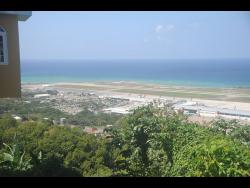When Condor Airlines landed at Sangster International Airport from Düsseldorf, Germany, last year, conditions were ideal: clear skies and low wind. But something was off.
“Ground, we may have hit a bird. You can check the runway,” said the pilot in an air traffic control recording obtained by the Financial Gleaner.
“Say again,” responded the controller, while dispatching a vehicle to inspect the runway.
The incident, which prompted at least one aircraft to circle while authorities investigated, underscores the vulnerability of aircraft during take-off and landing — when they are relatively slow and heavy, and most susceptible to bird strikes.
Forty-nine aircraft were struck by birds last year at Jamaica’s two main international airports, according to the GAP Sustainability Report produced by airport operator Grupo Aeroportuario del Pacífico, which translates to Pacific Airport Group in English. The report was released in July.
The bulk of the strikes — numbering 45 — occurred at Sangster International in Montego Bay; the other four were at Norman Manley International Airport, NMIA, in Kingston. The figures mark a 40 per cent increase over the previous year, placing Jamaica’s wildlife strike rate well above regional peers.
Sangster airport operator MBJ Airports Limited, a subsidiary of Mexican company GAP, confirmed that none of the 45 recorded strikes in 2024 caused damage or disrupted flights. Most occurred on the ground, similar to the Condor incident.
The culprits – or victims – included 18 swallows, three egrets, two sparrows, and 19 unidentified species. To mitigate risk, MBJ culled 627 birds last year, over half of which were egrets, followed by herons and other species.
MBJ Airports was “not” in a position to “speculate on factors that may influence wildlife activity patterns”. It added that the airport remains committed to maintaining safety standards while operating responsibly within the natural environment.
Still, MBJ Airports triggered its internal “alert level” for bird strikes in 2024, based on statistical thresholds, the Jamaica Civil Aviation Authority, JCAA, told the Financial Gleaner queries.
“Land usage near the airport hasn’t changed significantly, so the increase in strikes is likely multivariable,” reasoned JCAA Director General Nari Williams-Singh. Possible factors include “climate change and population growth”.
MBJ Airports is acquiring an aero laser to supplement its existing deterrents, which include pyrotechnics, sirens, patrols, vegetation control, and culling, Williams-Singh said.
Kingston, however, “does not have an increase in bird strikes,” said Sitara English-Byfield, the CEO of PAC Kingston Airport Limited, which operates NMIA on behalf of parent company GAP.
The National Environment and Planning Agency, NEPA, warns that bird strikes isn’t just an operational issue; it’s also an ecological concern.
“In addition to the obvious air traffic safety implications, the agency is also concerned from a biodiversity standpoint,” said NEPA spokeswoman Angela Hamilton. “Many of the bird species potentially involved may be protected under Jamaican law.”
NEPA encourages airports to consult with the environmental authorities before taking further action.
In addition to Sangster International and Norman Manley International in Jamaica, Pacific Airport Group manages another 12 airports in Mexico. The GAP Sustainability Report reveals that Jamaica’s wildlife strike rate — 7.99 per 10,000 aircraft movements — is significantly higher than Mexico’s 0.98 rate, despite Jamaica having fewer total flights.
Sangster International alone accounted for 44 per cent of the total 102 strikes across the 14 GAP-managed airports.
“It would be speculative to attribute the trend to any one factor, including nearby development, without a thorough and objective assessment,” Hamilton said of the rise in bird strikes.
Sangster International is Jamaica’s largest airport and a critical gateway for tourist traffic. As such, it is key to achieving the ‘Triple Five’ initiative, which targets growing tourist arrivals to five million visitors and earnings to US$5 billion by this year, 2025.
The authorities aim to balance aviation safety with ecology, before the next strike takes out more than just bird life.
